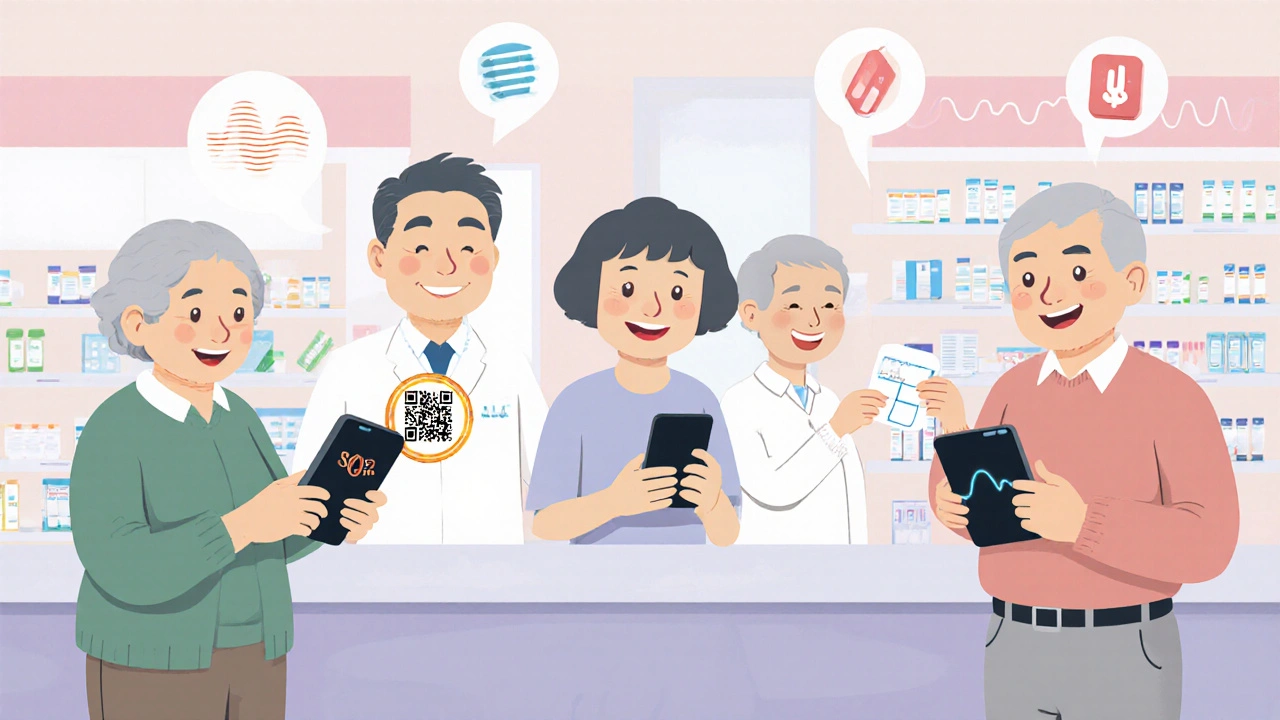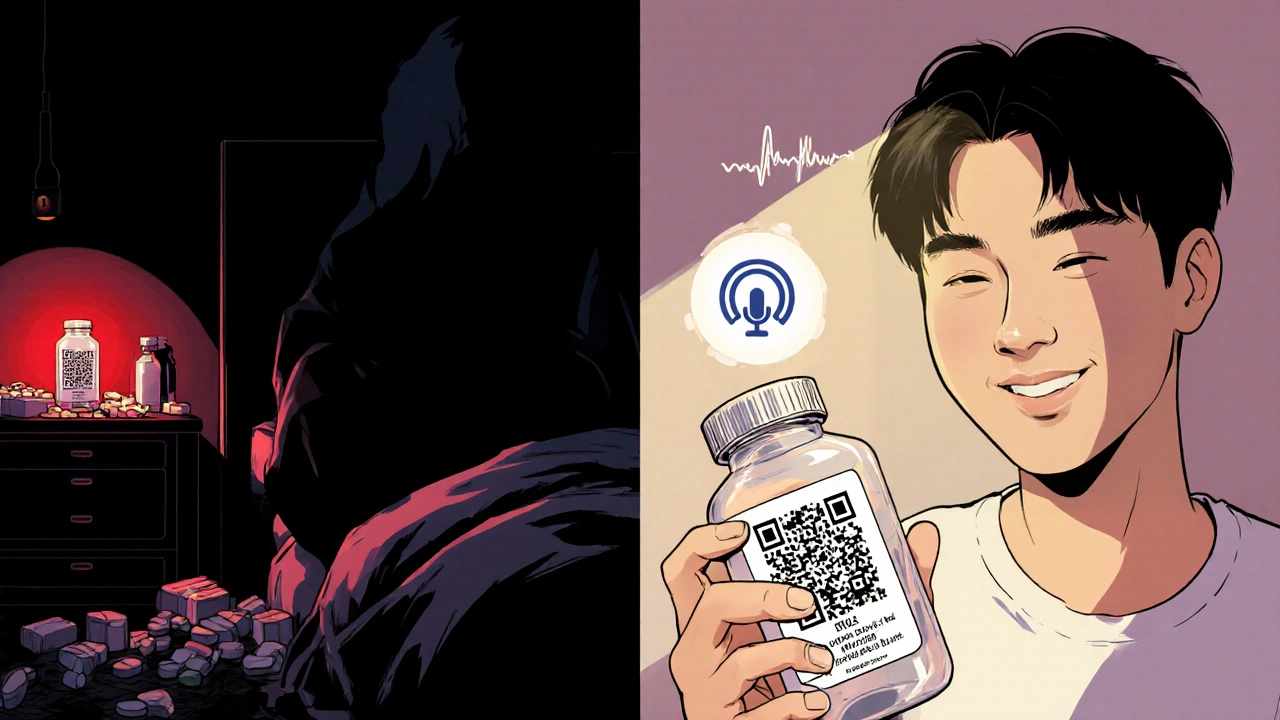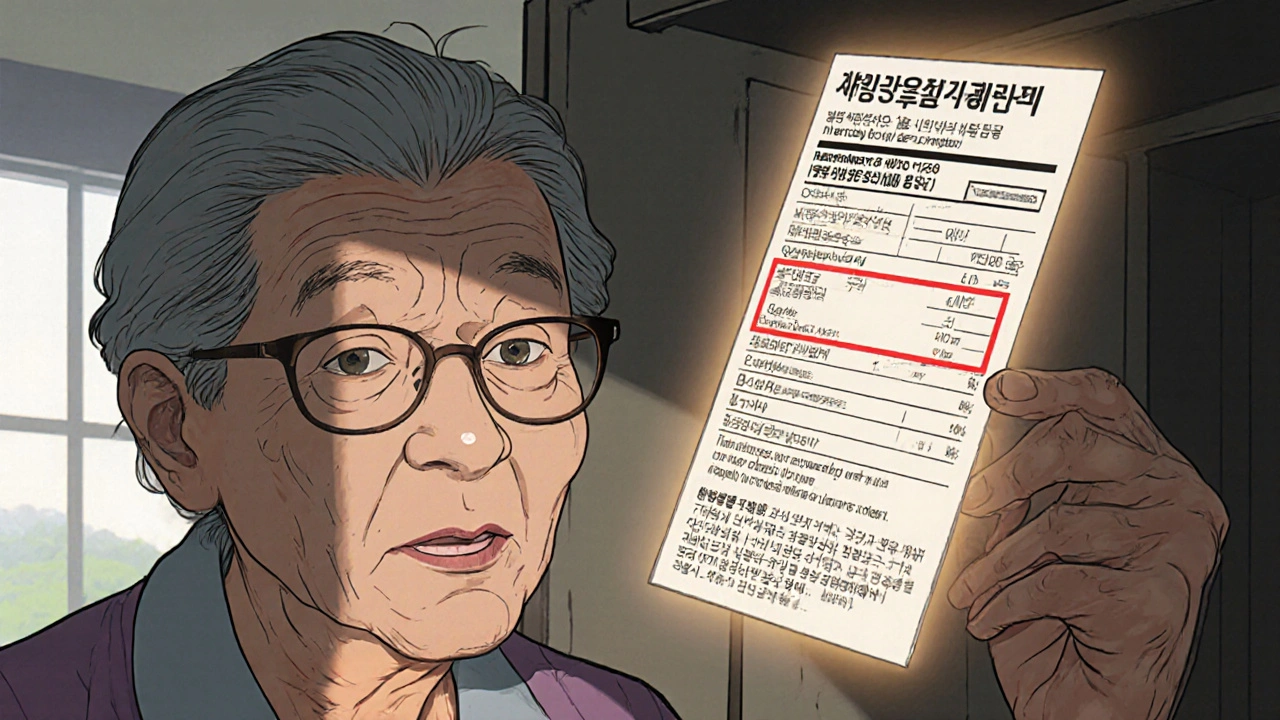Imagine opening your medicine cabinet and not being able to read what’s inside. Not just blurry text - but completely unreadable. For over 8 million Americans over 65 with low vision, this isn’t rare. It’s daily. And the stakes? Taking the wrong pill at the wrong time can land you in the ER - or worse.
Why Standard Prescription Labels Fail People with Low Vision
Most pharmacy labels are designed for perfect vision. Tiny font. Cluttered layout. Glare from glossy paper. The standard font size? Around 8 to 10 points. That’s smaller than the text on a smartphone notification. For someone with macular degeneration, glaucoma, or diabetic retinopathy, that’s unreadable. A 2021 CDC survey found that 1 in 5 adults over 45 struggle to read their own prescription labels. That’s not just inconvenient - it’s dangerous. People mix up pills. Miss doses. Take expired meds. The American Foundation for the Blind says medication errors due to inaccessible labels are one of the leading causes of preventable harm in older adults with vision loss.What Makes a Prescription Label Actually Accessible?
Accessible doesn’t mean “bigger font.” It means designed for real use. Here’s what works:- Font size: 18-point minimum - Studies show most people with low vision can’t read below 14-point. Experts recommend 18 to 24-point for safety.
- Font type: Sans-serif only - Arial, Verdana, or APHont™ (a free font made by the American Printing House for the Blind). Serif fonts like Times New Roman have tiny hooks that blur together for low vision.
- Contrast: Black on white - No gray text. No beige backgrounds. No yellow on white. High contrast is non-negotiable.
- Layout: Left-aligned, all lowercase - Instructions like “take one tablet by mouth daily” are easier to scan than ALL CAPS. Numbers should be uppercase for clarity.
- Non-glare material - Matte paper reduces reflections. Glossy labels are a nightmare under bright lights.
Some pharmacies use duplicate labels - a second, larger label stuck next to the original. That’s better than nothing, but it’s messy. The best labels are printed cleanly on the original container with enough space for all the info: drug name, dose, instructions, expiration, and pharmacy contact.
Large Print Isn’t the Only Option - Here Are the Real Solutions
Not everyone reads large print. Some people are completely blind. Others have trouble focusing on text even when it’s big. That’s why there are three main accessible formats:1. Large Print Labels
The most common solution. Simple. No tech needed. Just a bigger label. CVS, Walgreens, and Walmart all offer these for free. You don’t need a doctor’s note. Just ask. Some pharmacies keep 18-point labels in stock. Others print them on demand.2. ScripTalk - Talking Labels
This is RFID tech built into the label. You tap it with a small handheld device (or smartphone app) and it speaks the label info out loud. Drug name. Dose. Time to take it. Expiration date. All in clear, natural voice. It’s available in over 7,200 CVS locations and growing. Walgreens and some hospital pharmacies offer it too. The device costs $150-$200, but many insurance plans and Medicaid cover it. The catch? You need to know how to use it. Some older adults find the tech intimidating.3. QR Code + Audio Labels
UK HealthCare’s ScriptView system uses a QR code on the label. Scan it with your phone, and it plays an audio recording of the label info. You can listen as many times as you need. It also lets you download the audio to your phone for offline use. It’s free. No extra device needed. Just your smartphone. One 78-year-old diabetic patient reduced low blood sugar episodes by 75% after switching to this system.4. Braille Labels
Only about 10% of people with vision loss read Braille. So while it’s legally required under the ADA, it’s not the most widely used option. It also requires special printers and training. Most pharmacies don’t offer it unless requested.
How to Get Accessible Labels - Step by Step
You don’t need to wait for your pharmacy to offer this. You can ask - and you should.- Call ahead - Ask if they offer large print, talking, or audio labels. Don’t assume they do. Some staff don’t know.
- Be specific - Say: “I need my prescription label in 18-point Arial, black on white, no glare.”
- Ask for a duplicate label - If they can’t print it on the bottle, ask them to print a second one and stick it on.
- Request ScripTalk or QR audio - If you have a smartphone, ask for ScriptView. If you have a talking device, ask for ScripTalk.
- Get it in writing - Ask the pharmacist to note your preference in your file. That way, next time, it’s automatic.
Some pharmacies still make you ask twice. Don’t give up. You’re not being difficult - you’re protecting your health.
What Pharmacies Are Doing Right (and Wrong)
Major chains are leading the way. CVS, Walgreens, and Walmart all have formal programs. UK HealthCare’s ScriptAbility service - offering large print, audio, and translated labels - has a 4.7/5 rating from over 1,200 users. One common praise: “I finally feel safe taking my meds.” But independent pharmacies? Not so much. A 2022 survey by the American Pharmacists Association found that only 28% of small pharmacies have staff trained on accessible labeling. Many don’t stock 18-point labels. Some don’t even know the FDA requires it. The FDA’s 2012 Safety and Innovation Act made accessible labels mandatory. But enforcement is weak. In 2022, the Department of Justice settled three lawsuits over inaccessible labels - totaling $450,000 in fines. That’s a warning: if you’re denied, you have rights.
Real Stories - From Confusion to Confidence
On Reddit, a user named VisionLiberation wrote: “Since my pharmacy started offering 18-point labels, I stopped taking the wrong pills twice a week. It’s life-changing.” A 72-year-old woman in Toronto with glaucoma used to rely on her daughter to read her pills. After switching to a QR audio label, she started managing her own blood pressure meds. “I didn’t realize how much stress I was under,” she said. “Now I feel like I’m in control.” One study from the University of Kentucky tracked 500 patients over five years. Those using accessible labels had 38% fewer emergency visits due to medication errors.What’s Coming Next
The FDA is pushing for digital accessibility. By 2026, electronic prescriptions and patient portals must include accessible label options. That means apps will need to read your prescriptions aloud - even if you’re not near the bottle. New tech like Be My Eyes’ AI-powered label reader is already in use. Point your phone at the label, connect to a volunteer, and they read it to you in real time. Over 1.2 million label reads happen every month. The goal? 100% of U.S. pharmacies offering large print labels by 2026. That’s not a dream - it’s a legal and moral requirement.Final Thoughts: This Isn’t a Luxury - It’s a Lifeline
Accessible prescription labels aren’t about convenience. They’re about survival. For people with low vision, reading a label isn’t a preference - it’s the difference between staying healthy and ending up in the hospital. If you or someone you love has trouble reading prescriptions, don’t wait. Ask your pharmacy today. If they say no, ask again. And if they still say no, contact your state pharmacy board. You’re not asking for a favor. You’re claiming your right to safe, independent care.The technology exists. The law supports you. All you need to do is speak up.


Nathan Hsu
November 14, 2025 AT 04:09Wow, this is such a critical issue-seriously, why aren’t pharmacies required by law to print labels in 18-point font?!! It’s not like we’re asking for gold-plated pill bottles; it’s basic human dignity!! I’ve seen my uncle nearly choke on his meds because he mistook lisinopril for losartan… and he’s got a PhD!!
Also, can we talk about how ridiculous it is that some places still use glossy labels?? It’s like they’re trying to blind us on purpose!!
And why is Braille still treated like a novelty? It’s not 1987!! We have the tech!!
Also, QR codes? Genius. My aunt in Mumbai uses one-she scans with her phone, and it reads it out in Hindi, English, and Tamil. Why can’t the U.S. do that??
Also-ScripTalk? I didn’t even know that existed!!
Also-why isn’t this on the nightly news??
Also-I’m sending this to my senator.
Ashley Durance
November 15, 2025 AT 19:43Let’s be real-this isn’t about accessibility. It’s about entitlement. If you can’t read small print, get glasses. Or hire someone. Or use a magnifier. It’s not the pharmacy’s job to cater to every sensory preference. The FDA doesn’t mandate font size for cereal boxes, so why prescription labels? The answer? Because someone sued. Again.
And don’t get me started on QR codes. Most elderly people can’t even open their own email. You think they’re scanning barcodes? Please. This is tech theater wrapped in virtue signaling.
Also, ‘18-point minimum’? That’s arbitrary. I’ve seen 14-point labels that are perfectly legible. You’re setting a precedent that will inflate costs for everyone. And who pays? You do, through higher premiums.
And don’t even get me started on ‘audio labels.’ Next thing you know, we’ll need voice-activated insulin dispensers. This isn’t innovation-it’s overreach.
Scott Saleska
November 16, 2025 AT 03:26Hey, I just wanted to say-I work at a small pharmacy in Ohio, and we don’t have 18-point labels in stock. We’ve never been trained on this. I didn’t even know it was a federal requirement until I read this post. I feel terrible. I’ve had people come in, squinting, asking if we could ‘make it bigger.’ I said ‘I’ll try.’ But I didn’t know how.
Now I’m printing out a 24-point Arial label on matte paper for every patient who asks. No more excuses. I’m going to call the state pharmacy board tomorrow and ask for training materials. This isn’t about politics-it’s about people. And I’m sorry I didn’t do better before.
Also, if anyone has a link to the FDA guidelines on this, I’d really appreciate it. I want to get it right.
Ryan Anderson
November 16, 2025 AT 21:35This is one of those topics that makes you feel both heartbroken and hopeful. 😔❤️
My grandma used to take her meds by color-red pill = morning, blue pill = night. One day she mixed up the bottles because the labels looked identical. She ended up in the ER. Took us three weeks to fix her system.
Now she uses ScripTalk. She calls it her ‘little robot voice.’ She’s so proud of it. And she doesn’t need her kids to read her pills anymore. That’s not just convenience-that’s dignity.
Also, QR audio? YES. My phone does everything else. Why shouldn’t it read my meds? No extra device. No cost. Just a scan. Why isn’t this everywhere?
Pharmacies: Stop making people beg. Just do it. It’s not hard. And if you don’t know how? Ask. This post is your manual.
And to the person who said ‘get glasses’-have you ever tried reading a 7-point font while your vision is foggy from glaucoma? It’s not a lens problem. It’s a design failure. And design failures cost lives.
Eleanora Keene
November 16, 2025 AT 21:59Hi everyone-just wanted to say thank you for sharing this. I’ve been trying to help my mom navigate this for years, and it’s been so frustrating. She’s 74, has diabetic retinopathy, and we’ve had to call three different pharmacies before one actually knew what we were talking about.
But yesterday? We walked in, asked for the large print label, and they printed it on the spot. No drama. No attitude. Just kindness.
She cried. I cried. It’s not about the font size-it’s about being seen. And that matters more than we realize.
If you’re a pharmacist reading this: thank you for doing the right thing. You have no idea how much you’re changing lives.
And if you’re someone who’s scared to ask? Please, don’t be. You’re not being difficult. You’re being brave.
Joe Goodrow
November 17, 2025 AT 14:16Look, I get it. But this is just another example of woke culture taking over. We used to be able to read small print. We used to be able to figure things out. Now we need QR codes and talking labels just to take a pill? What’s next? Voice-activated toothpaste?
And why is this only for Americans? In my dad’s village in Romania, people read tiny labels for decades. No one had a problem. No one sued. No one complained. They just lived.
This isn’t about health. It’s about making people feel special. And it’s costing taxpayers billions.
Also, I don’t care if the FDA says something. If it’s not in the Constitution, I’m not paying for it.
Don Ablett
November 18, 2025 AT 14:47The statistical correlation between accessible labeling and reduced emergency visits is compelling. The University of Kentucky study cited reports a 38 percent reduction in medication-related hospitalizations among participants using compliant labels. This suggests a significant public health benefit. However, the economic implications of mandating such changes across all 68,000 U.S. pharmacies remain unquantified in the literature. A cost-benefit analysis would be necessary to determine scalability. Additionally, the prevalence of Braille literacy among the visually impaired population is approximately 10 percent, which may limit the utility of that modality. Further research into user preference and technological adoption rates is warranted.
Kevin Wagner
November 20, 2025 AT 06:58THIS. IS. A. REVOLUTION. 🚀
Stop treating people with low vision like they’re broken. They’re not. The system is. And we’re fixing it. One label at a time.
I used to think this was just about font size. Now I know it’s about power. Who gets to be seen? Who gets to be safe? Who gets to be independent?
My cousin used to hide her pills because she was too embarrassed to ask for help. Now she scans her QR code and says, ‘Hey Siri, read my meds.’ And she laughs. She actually laughs.
That’s not a tech upgrade. That’s liberation.
So if your pharmacy says no? Tell them this: ‘I’m not asking for a favor. I’m claiming my right to live without fear.’
And if you’re a pharmacist? Don’t wait for a lawsuit. Don’t wait for a mandate. Do it because it’s right. Because you’re not just dispensing medicine-you’re dispensing hope.
Let’s make every label a lifeline. 💪❤️